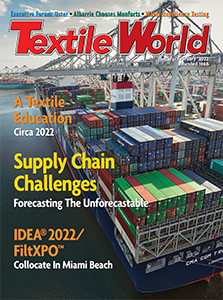WILMINGTON, Del. — March 11, 2022 — The Accelerating Circularity Project commissioned research and a white paper on the potential workforce opportunities created as we shift from a linear business model to a circular one of textiles-to-textiles recycling. The mission of ACP is to establish systems that will use the embedded value and resources in existing textiles for new products, reducing the 17 million tons in the USA1and 5 million tons in Europe of post-consumer waste2that goes to landfills annually. Thus, supporting the reduction of the industry’s environmental impacts.
“Through research and stakeholder participation, our report aims to show how the USA workforce can emerge stronger while the entities investing in textile circularity can take advantage of an evolving industry,” shared Karla Magruder, Founder & President of ACP. “Sustainability has three pillars: environmental, economic, and social. ACP is focused on demonstrating and quantifying the environmental and economic impact through trials that are in progress. Research on future employment is an important social aspect of the circular economy that warranted addressing.”
As the textile recycling sector grows as part of the circular economy, more workers will be needed to collect, sort, and process recyclables. The value chain for Textile Reuse & Resale model is already functioning, profitable, and growing fast:
- According to Thredup/Boston Consulting Group, the vintage & resale market was valued at $28 billion in 2020 and is forecast to grow to $64 billion by 20243
- 美国人口普查局确定了超过19200个零售地点,超过201,000的劳动力4
纺织到纹理的回收模型仍在不断发展,并将提供一些长期的战略优势,即重用/转售营销没有。示例包括:
- No competition with new fashion retail sector/employment5
- Potential to support the onshoring and therefore the growth of the existing workforce6
- Job creation to meet anticipated $40.3 billion in eco-fiber demand by 20277
排序是一个关键功能,尽管今天通常将其视为最低补偿的入门级,非熟练工作,同时又是身体上要求的。重用/转售市场依赖于强烈的分类来通过可重复使用的物品的评分来产生收入。尽管某些技术正在开发并可以自动化排序过程的特定部分,但它们并不能完全运行。接受本研究采访的许多人认为,分类将仍然是自动化和体力劳动的结合。
The post-consumer textile collection has both a workforce as well as an infrastructure development opportunity to make the consumer donation of unwanted clothing more convenient and to maximize the diversion from landfills. A 2020 study by the European Apparel and Textile Confederation (EURATEX) estimates that about 20 jobs can be created for every 1000 metric tons of textiles collected, sorted, and recycled in the European Union8.
Many of the stakeholders interviewed for this study commented that policy and legislation can also be critical in empowering job creation and the establishment of a circular economy.
For more information, please sign up for a webinar on March 24 at 11 am EST (U.S. and Canada)
Register in advance for this meeting: https://us02web.zoom.us/meeting/register/tZApcemtrDspG9Hx9bqHZf2nkOyvKwbeymDj
1https://www.epa.gov/facts-and-figures-about-materials-waste-and-recycling/textiles-material-specific-data#TextilesTableandGraph
2https://publications.jrcec.europa.eu/repository/handle/JRC125110k p.8
3https://www.thredup.com/resale/2020/#resale-growth
4U.S. Census Bureau, All Sectors: County Business Patterns, including ZIP Code Business Patterns, by Legal Form of Organization and Employment Size Class for the U.S., States, and Selected Geographies (2019)
5Ellen MacArthur Foundation (EMF), A new textiles economy: Redesigning fashion’s future (2017)
6Organization for Economic Cooperation and Development (OECD), Labor market consequences of a transition to a circular economy (2020)
7Circular Fashion Summit, Circular Fashion Report 2020: Year Zero (2020)
8EURATEX, ReHubs: A joint initiative for industrial upcycling of textile waste & circular materials (2020)
Posted: March 11, 2022
来源:加速循环




